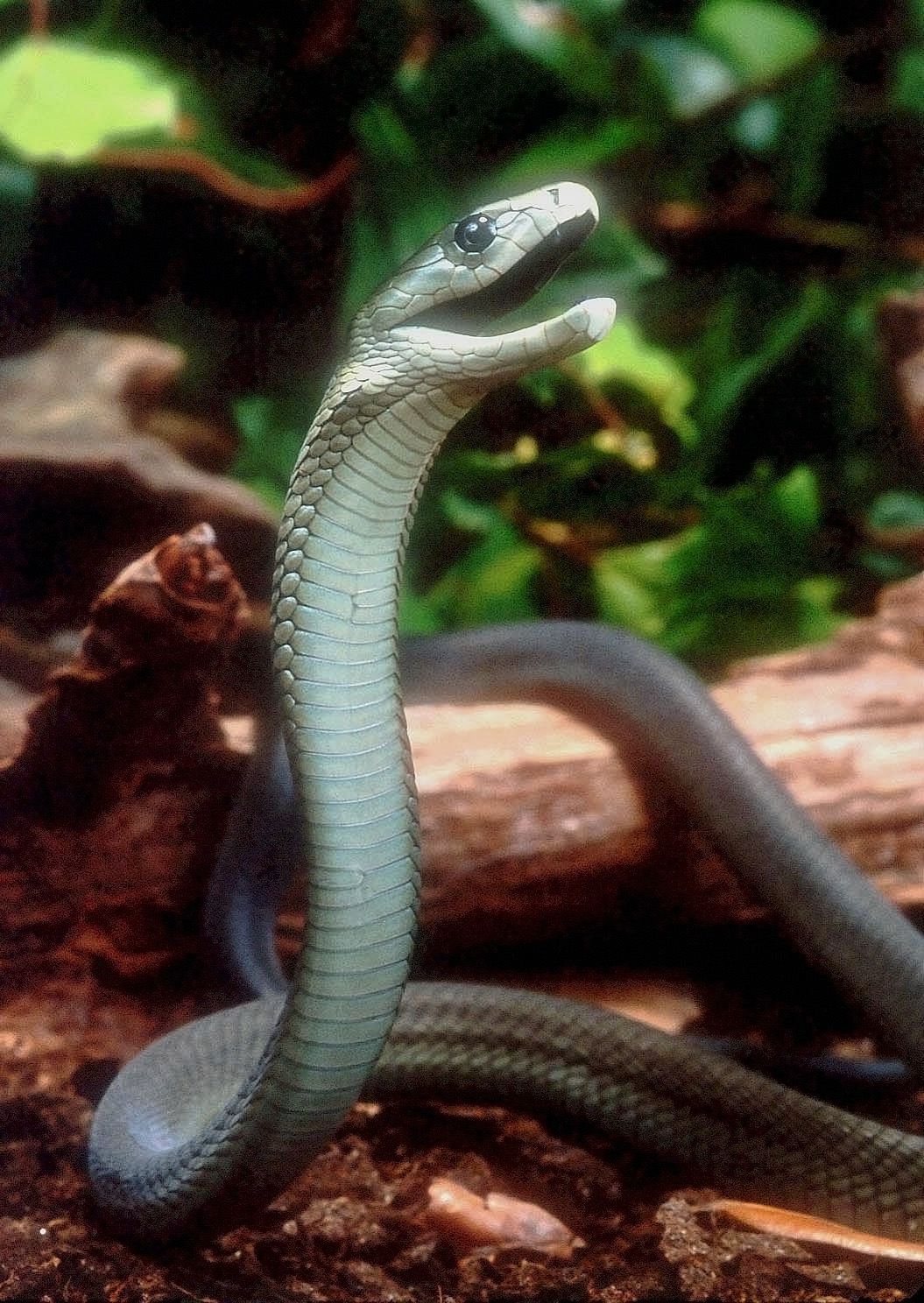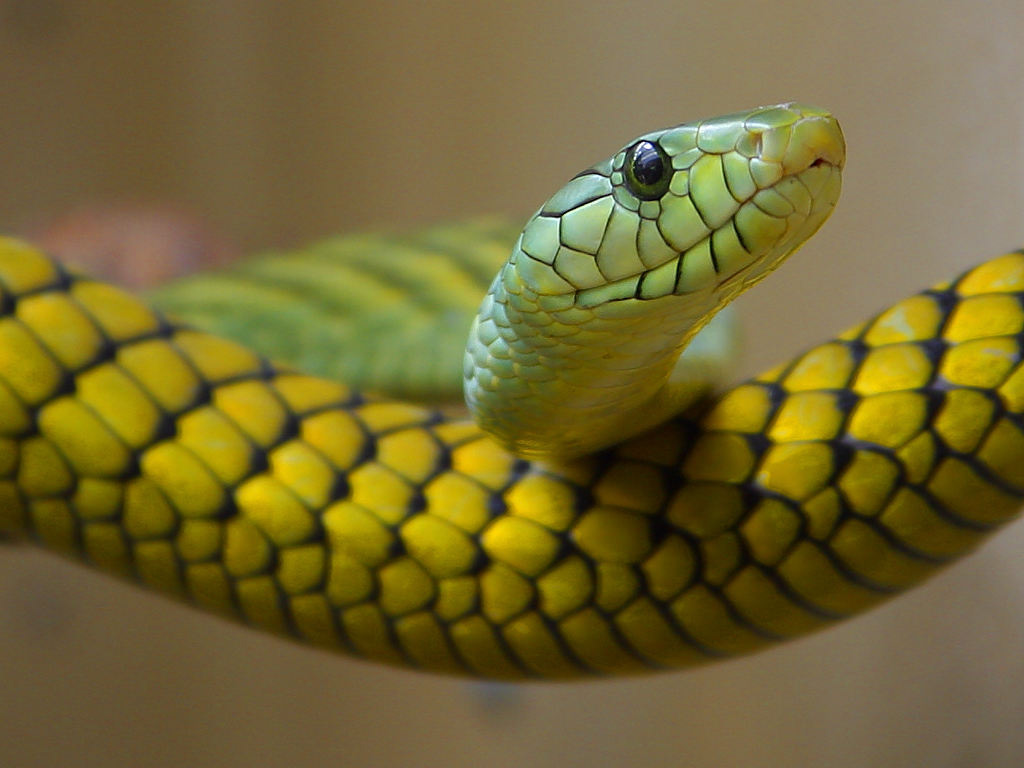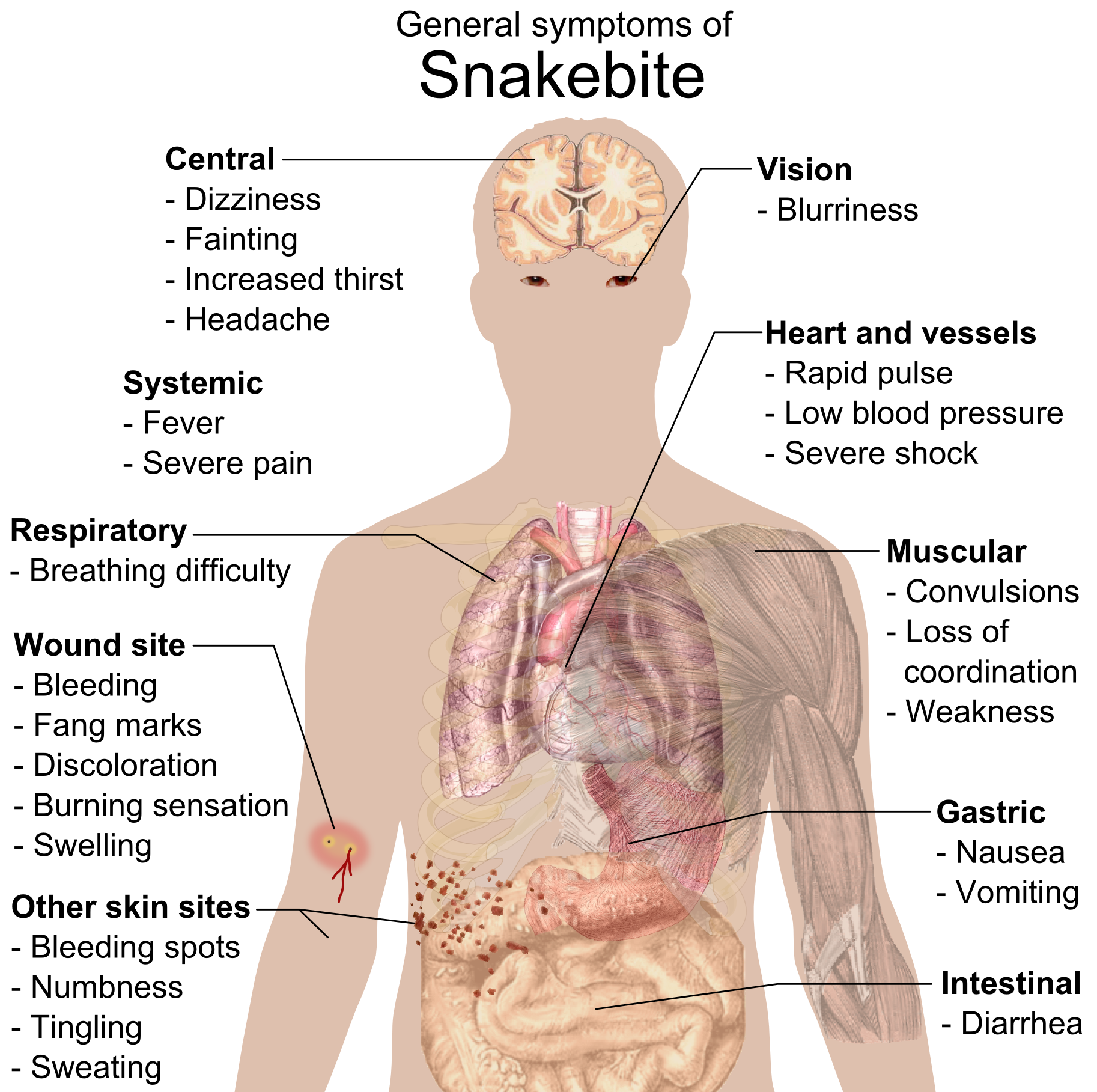|
Dendroaspis
Mambas are fast-moving, highly venomous snakes of the genus ''Dendroaspis'' (which literally means "tree asp") in the family Elapidae. Four extant species are recognised currently; three of those four species are essentially arboreal and green in colour, whereas the black mamba, ''Dendroaspis polylepis'', is largely terrestrial and generally brown or grey in colour. All are native to various regions in sub-Saharan Africa and all are feared throughout their ranges, especially the black mamba. In Africa there are many legends and stories about mambas. also at/ref> Behaviour The three green species of mambas are arboreal, whereas the black mamba is largely terrestrial. All four species are active diurnal hunters, preying on birds, lizards, and small mammals. At nightfall some species, especially the terrestrial black mamba, shelter in a lair. A mamba may retain the same lair for years. Resembling a cobra, the threat display of a mamba includes rearing, opening the mouth and hissin ... [...More Info...] [...Related Items...] OR: [Wikipedia] [Google] [Baidu] |
Black Mamba
The black mamba (''Dendroaspis polylepis'') is a species of highly venomous snake belonging to the family Elapidae. It is native to parts of sub-Saharan Africa. First formally species description, described by Albert Günther in 1864, it is the second-longest venomous snake after the king cobra; mature specimens generally exceed and commonly grow to . Specimens of have been reported. It varies in colour from grey to dark brown. Juvenile black mambas tend to be more pale in colour than adults, and darken with age. Despite the common name, the black mamba is not black; the colour name describes rather the inside of its mouth, which it displays when feeling threatened. The species is both terrestrial animal, terrestrial (ground-living) and arboreal (tree-living); it inhabits savannah, woodland, rocky slopes and in some regions, dense forest. It is Diurnality, diurnal and is known to prey on birds and small mammals. Over suitable surfaces, it can move at speeds up to for short ... [...More Info...] [...Related Items...] OR: [Wikipedia] [Google] [Baidu] |
Dendroaspis Angusticeps
The eastern green mamba (''Dendroaspis angusticeps'') is a highly venomous snake species of the mamba genus ''Dendroaspis'' native to the coastal regions of southern East Africa. Species description, Described by Scottish people, Scottish surgeon and zoologist Andrew Smith (zoologist), Andrew Smith in 1849, it has a slender build with a bright green back and green-yellow ventral scales. Adult females average around in length, and males are slightly sexual dimorphism, smaller. In spite of common urban legends and misconceptions labeling the eastern green mamba an aggressive, fast-moving “people-chaser”, it is in fact a shy and elusive species that remains hidden in the trees, and is rarely seen. This seclusion is usually attributed to its arboreal habitat and green colouration, which acts as effective camouflage in its natural environment. Even with its deadly venom, the green mamba has to protect itself from predators, including Accipitriformes, birds of prey and other snakes ... [...More Info...] [...Related Items...] OR: [Wikipedia] [Google] [Baidu] |
Dendroaspis Polylepis
The black mamba (''Dendroaspis polylepis'') is a species of highly venomous snake belonging to the family Elapidae. It is native to parts of sub-Saharan Africa. First formally described by Albert Günther in 1864, it is the second-longest venomous snake after the king cobra; mature specimens generally exceed and commonly grow to . Specimens of have been reported. It varies in colour from grey to dark brown. Juvenile black mambas tend to be more pale in colour than adults, and darken with age. Despite the common name, the black mamba is not black; the colour name describes rather the inside of its mouth, which it displays when feeling threatened. The species is both terrestrial (ground-living) and arboreal (tree-living); it inhabits savannah, woodland, rocky slopes and in some regions, dense forest. It is diurnal and is known to prey on birds and small mammals. Over suitable surfaces, it can move at speeds up to for short distances. Adult black mambas have few natural pre ... [...More Info...] [...Related Items...] OR: [Wikipedia] [Google] [Baidu] |
Dendroaspis Jamesoni
Jameson's mamba (''Dendroaspis jamesoni)'' is a species of highly venomous snake in the Family (biology), family Elapidae. The species is native to equatorial Africa. A member of the mamba genus, ''Dendroaspis'', it is slender with dull green upper parts and cream underparts and generally ranges from in total length. Species description, Described by Scottish naturalist Thomas Stewart Traill, Thomas Traill in 1843, it has two recognised subspecies. The Subspecies#Nominate subspecies, nominate subspecies is found in central and western sub-Saharan Africa, and the eastern black-tailed subspecies is found eastern sub-Saharan Africa, mainly western Kenya. Predominantly Arboreal locomotion, arboreal, Jameson's mamba predation, preys mainly on birds and mammals. Its venom consists of both neurotoxins and cardiotoxins. Symptoms of envenomation in humans include pain and swelling at the bite site, followed by swelling, chills, sweating, abdominal pain and vomiting, with subsequent slurre ... [...More Info...] [...Related Items...] OR: [Wikipedia] [Google] [Baidu] |
Dendroaspis Viridis
The western green mamba (''Dendroaspis viridis'') is a long, thin, and highly venomous snake species of the mamba genus, ''Dendroaspis''. This species was first described in 1844 by American herpetologist Edward Hallowell. The western green mamba is a fairly large and predominantly arboreal species, capable of navigating through trees swiftly and gracefully. It will also descend to ground level to pursue prey such as rodents and other small mammals. The western green mamba is a shy and agile snake that lives mainly in the coastal tropical rainforest, thicket, and woodland regions of western Africa. Its venom is a highly potent mixture of rapid-acting presynaptic and postsynaptic neurotoxins (dendrotoxins), cardiotoxins and fasciculins. Some consider this species not to be a particularly aggressive snake, but others have suggested that they are extremely nervous and are prone to attack aggressively when cornered. Conflict with humans is low compared to some other species found in ... [...More Info...] [...Related Items...] OR: [Wikipedia] [Google] [Baidu] |
Dendrotoxin
Dendrotoxins are a class of presynaptic neurotoxins produced by mamba snakes ('' Dendroaspis'') that block particular subtypes of voltage-gated potassium channels in neurons, thereby enhancing the release of acetylcholine at neuromuscular junctions. Because of their high potency and selectivity for potassium channels, dendrotoxins have proven to be extremely useful as pharmacological tools for studying the structure and function of these ion channel proteins. Dendrotoxins have been shown to block particular subtypes of voltage-gated potassium (K+) channels in neuronal tissue. In the nervous system, voltage-gated K+ channels control the excitability of nerves and muscles by controlling the resting membrane potential and by repolarizing the membrane during action potentials. Dendrotoxin has been shown to bind the nodes of Ranvier of motor neurons and to block the activity of these potassium channels. In this way, dendrotoxins prolong the duration of action potentials and increa ... [...More Info...] [...Related Items...] OR: [Wikipedia] [Google] [Baidu] |
Elapidae
Elapidae (, commonly known as elapids , from , variant of "sea-fish") is a family of snakes characterized by their permanently erect fangs at the front of the mouth. Most elapids are venomous, with the exception of the genus '' Emydocephalus''. Many members of this family exhibit a threat display of rearing upwards while spreading out a neck flap. Elapids are endemic to tropical and subtropical regions around the world, with terrestrial forms in Asia, Australia, Africa, and the Americas and marine forms in the Pacific and Indian Oceans. Members of the family have a wide range of sizes, from the white-lipped snake to the king cobra. Most species have neurotoxic venom that is channeled by their hollow fangs, and some may contain other toxic components in varying proportions. The family includes 55 genera with around 360 species and over 170 subspecies. Description Terrestrial elapids look similar to the Colubridae; almost all have long, slender bodies with smooth scales, ... [...More Info...] [...Related Items...] OR: [Wikipedia] [Google] [Baidu] |
Fasciculin
Fasciculins are a class of toxic proteins found in certain snake venoms, notably some species of mamba. Investigations have revealed distinct forms in some green mamba venoms, in particular FAS1 and FAS2 Fasciculins are so called because they cause intense fasciculation in muscle fascicles of susceptible organisms, such as the preferred prey of the snakes. This effect helps to incapacitate the muscles, either killing the prey, or paralysing it so that the snake can swallow it. Fundamental mechanism of action The mechanism of action of FAS proteins is associated with attachment to molecules within muscular acetylcholinesterase, and at neuromuscular junctions, thus conferring their ability to interfere with neuromodulatory inhibition. Molecular nature and physiological effect Fasciculins from mambas inhibit mammalian and fish acetylcholinesterases intensely, but are less active against the corresponding enzymes in insects, reptiles and birds. As one might expect of fast-acting ven ... [...More Info...] [...Related Items...] OR: [Wikipedia] [Google] [Baidu] |
Snakebites
A snakebite is an injury caused by the bite of a snake, especially a venomous snake. A common sign of a bite from a venomous snake is the presence of two puncture wounds from the animal's fangs. Sometimes venom injection from the bite may occur. This may result in redness, swelling, and severe pain at the area, which may take up to an hour to appear. Vomiting, blurred vision, tingling of the limbs, and sweating may result. Most bites are on the hands, arms, or legs. Fear following a bite is common with symptoms of a racing heart and feeling faint. The venom may cause bleeding, kidney failure, a severe allergic reaction, tissue death around the bite, or breathing problems. Bites may result in the loss of a limb or other chronic problems or even death. The outcome depends on the type of snake, the area of the body bitten, the amount of snake venom injected, the general health of the person bitten, and whether or not anti-venom serum has been administered by a doctor in a ... [...More Info...] [...Related Items...] OR: [Wikipedia] [Google] [Baidu] |
M4 Receptors
The muscarinic acetylcholine receptor M4, also known as the cholinergic receptor, muscarinic 4 (CHRM4), is a protein that, in humans, is encoded by the ''CHRM4'' gene. Function M4 muscarinic receptors are coupled to Gi/o heterotrimeric proteins. They function as inhibitory autoreceptors for acetylcholine. Activation of M4 receptors inhibits acetylcholine release in the striatum. The M2 subtype of acetylcholine receptor functions similarly as an inhibitory autoreceptor to acetylcholine release, albeit functioning actively primarily in the hippocampus and cerebral cortex. Muscarinic acetylcholine receptors possess a regulatory effect on dopaminergic neurotransmission. Activation of M4 receptors in the striatum inhibit D1 receptor, D1-induced hyperlocomotion, locomotor stimulation in mice. M4 receptor-deficient mice exhibit increased locomotor simulation in response to dopamine agonist, D1 agonists, amphetamine and cocaine. Neurotransmission in the striatum influences extrapyrami ... [...More Info...] [...Related Items...] OR: [Wikipedia] [Google] [Baidu] |
Venomous Snake
''Venomous snakes'' are species of the suborder Serpentes that are capable of producing venom, which they use for killing prey, for defense, and to assist with digestion of their prey. The venom is typically delivered by injection using hollow or grooved fangs, although some venomous snakes lack well-developed fangs. Common venomous snakes include the families Elapidae, Viperidae, Atractaspididae, and some of the Colubridae. The toxicity of venom is mainly indicated by murine , while multiple factors are considered to judge the potential danger to humans. Other important factors for risk assessment include the likelihood that a snake will bite, the quantity of venom delivered with the bite, the efficiency of the delivery mechanism, and the location of a bite on the body of the victim. Snake venom may have both neurotoxic and hemotoxic properties. There are about 600 venomous snake species in the world. Evolution The evolutionary history of venomous snakes can be traced back ... [...More Info...] [...Related Items...] OR: [Wikipedia] [Google] [Baidu] |






